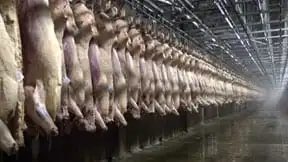
There are so many different kinds of industries that OSHA provides safety standards for. These standards are put in place for the very specific purpose of minimizing injuries and fatalities in any workplace. This includes construction industries, medical industries, and, not surprisingly, slaughterhouses. In recent years, slaughterhouses have become a safer place to work that they were in the past. However, according to npr.org, the data gathered by federal regulators doesn’t likely capture all the risks that meat and poultry workers face. The following article covers more detail on the circumstances that meat and poultry workers face.
“In an update to a 2005 report criticizing safety conditions for workers in the meat industry, the Government Accountability Office says injuries and illnesses are still common. From 2004 to 2013, 151 meat and poultry workers died from injuries sustained at work. The injury rate for meat workers is higher than the rest of the manufacturing industry.
But injuries in the meat industry are also likely to be underreported.
The GAO found several situations that may keep reported numbers from packing plants lower than reality. Here are some examples:
- Sanitary workers who clean machinery in meat plants have suffered amputated limbs and severed fingers. Some have died on the job. But their cases are not always counted with meat and poultry industry data because many work for third-party contractors.
- Medical staff at on-site clinics have encouraged workers to return to the line without seeing a doctor for pain. GAO cited a case where a worker made 90 visits to a nursing station before being referred to a physician.
- Meat and poultry workers are often immigrants or refugees. They may downplay or not report injuries to protect their jobs and livelihoods. Language barriers can also prevent workers from receiving proper safety training.
“These limitations in [the Department of Labor’s] data collection raise questions about whether the federal government is doing all it can to collect the data it needs to support worker protection and workplace safety,” the GAO report said.
The GAO says safety researchers at the Centers for Disease Control and Prevention should do more to study sanitation worker injuries and regulators should count those injuries alongside those sustained by other meat workers.
Worker advocates say they have long been suspicious of the injury rates reported by meat companies. For instance, a recent study at a Maryland poultry plant by the National Institute for Occupational Safety and Health (NIOSH) found that one-third of workers had injuries that meet the definition of carpal tunnel, but only a handful of injuries had been reported to OSHA.
When injuries aren’t reported and treated, advocates say, they get worse.
“It has profound consequences for the workers,” says Celeste Monforton, an occupational health researcher at George Washington University. “Their injuries are exacerbated, some beyond repair.”
In recent years, groups like Nebraska Appleseed and the Southern Poverty Law Center have highlighted working conditions that they say continue to put people at risk, such as fast line speeds that can cause repetitive motion injuries. And Oxfam found that poultry workers are often denied mandatory bathroom breaks during the workday. Workers said they ended up wearing adult diapers.
The North American Meat Institute, a trade group, issued a statement defending the meat industry’s record on worker safety records. It said that OSHA has reviewed injury recordkeeping and did not find underreporting to be a regular problem at meatpacking facilities. NAMI also said that the rate of reported injuries is at an all-time low.
In an interview before the report was released, NAMI safety director Dan McCausland said the meat industry has made strides in safety over the past few decades.
‘If you go back to the late ’80s, early ’90s — particularly in slaughtering facilities — it was not uncommon to have a third of the employees have an injury significant enough to wind up on the OSHA 300 log every year,” McCausland said, referring to the OSHA form used to report workplace injuries. “Now it’s down in the 10 percent and below [range]. We have many facilities running 3 percent or less.'”
Even meat and poultry workers face hazards and safety violations. It is important for any worker in any industry to be properly trained, and to receive the right treatment in their facility. Safety should be the number one priority in any workplace. Make sure you and those around are safe, with the proper training, and by following proper procedures.
